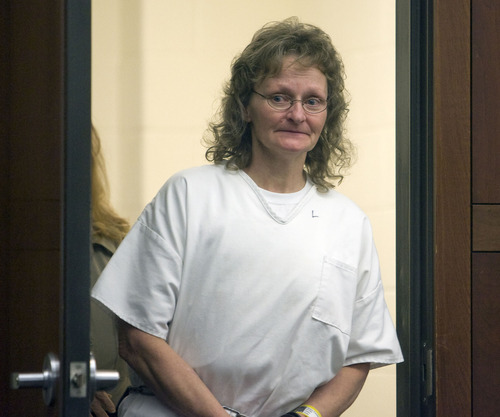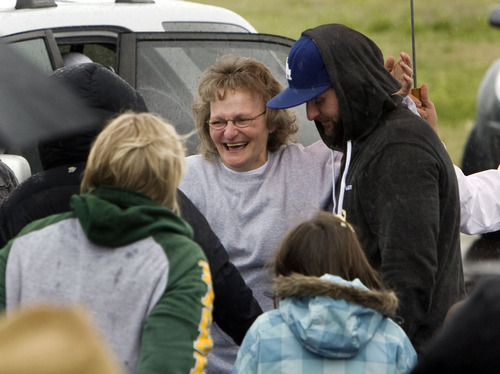This is an archived article that was published on sltrib.com in 2013, and information in the article may be outdated. It is provided only for personal research purposes and may not be reprinted.
A woman who spent nearly two decades in prison for shooting her boss in the head is innocent of the crime, the Utah Supreme Court ruled Friday.
In a decision released Friday morning, the court found that Debra Brown, 55, was "factually innocent" in the 1993 murder of Lael Brown. The two are unrelated. Friday's ruling supports a 2011 decision by a 2nd District Court Judge.
A jury convicted Debra Brown in 1995 and she subsequently spent 17 years in prison before the district court judge ruled that she was factually innocent in 2011. She left prison May 9, 2011. Had the supreme court overturned the 2011 decision Brown could potentially have faced more time behind bars.
Instead, Friday's ruling means that Brown will remain free and is entitled to roughly half a million dollars in compensation.
Attorney Jensie Anderson — who worked on the case and is legal director at the Rocky Mountain Innocence Center and a professor at the University of Utah — said the money will help Brown maintain housing and get access to health care, which is vital because she is a two-time cancer survivor.
"I don't see it as a lot of money. I see it as a reasonable amount of money," Anderson said. "But it's never ever been about the money to her. What she cares about truly is being home."
Anderson spoke with Brown soon after the decision came out Friday morning, and after that conversation said Brown was "probably as happy as I've ever heard her." Anderson added that Brown felt relieved and vindicated and was looking forward to living in peace.
Assistant Attorney General Christopher Ballard said Friday that he was disagreed with the decision but respected the Supreme Court's conclusions. He added that state attorneys opted to fight the initial factual innocence ruling because they believed — and continue to believe — that Debra Brown killed Lael Brown.
"If we believed that she did not commit this murder, we would not have challenged this on appeal," Ballard said. "We challenged it because we have always believed that the jury got it right."
Brown was the first Utah convict to be found factually innocent of a crime under a law that allows for such a finding without new DNA evidence. The case began after she reported finding Lael Brown dead at his home Nov. 7, 1993. He was lying in bed with three gunshot wounds in his head, according to court documents.
Debra Brown had no alibi for the previous morning. Prosecutors subsequently used the lack of an alibi as part of their circumstantial case against her, saying at a 1995 trial that she must have shot Lael in the early morning hours of Nov. 6. In support of their argument, prosecutors said a witness heard gunshots at that time and Debra had a key to Lael's home, which showed no signs of forced entry.
But in 2011, two witness statements cast doubt on prosecutors' version of events. The witnesses testified during a week of hearings and told 2nd District Judge Michael DiReda they had seen Lael Brown alive the afternoon of Nov. 6 — after he had supposedly been murdered and when Brown did have an alibi. Court documents single out the testimony of Delwin Hall, who said he saw Lael Brown at Angie's restaurant in Logan on Saturday afternoon.
Hall's testimony became a source of legal wrangling. He had been on the defense witness list during the original trial, but Brown's lawyers never called him to testify. As a result, the state had contended that Hall's testimony was not new evidence and therefore couldn't be used to vindicate Brown.
Ballard further explained Friday that according to the state's understanding of Utah law, a convict hoping to be cleared needs to bring something to the case that was never brought up before and that "conclusively proves" factual innocence. Ballard and other state attorneys did not believe Hall's testimony fit that description and in September argued that a judge wrongly exonerated Brown based on incorrect and old evidence.
The supreme court decision rejected the state's reading of the law and cleared up the old versus new issue, saying that "factual innocence can be based on both newly discovered evidence and previously available evidence."
Ballard said the decision sets a new precedent about what kind of evidence can establish factual innocence. He added that it also sets a precedent about "how strong that evidence has to be." He was referring to the fact that state attorneys never believed Brown's so-called new evidence actually proved her innocence. Among other things, they have pointed out that the 75-year-old man did not show up to make plumbing repairs at a home, as he had promised. Nor did he show up for his regular coffee with friends that morning.
"She still has not shown that she didn't kill him at any other time," Ballard said at a September hearing. The state believes Brown killed the man as a cover up for forging multiple checks; Brown has admitted to forging the checks.
Anderson explained Friday that the state didn't challenge the facts presented by the defense. Instead, the state merely believed those facts didn't prove Brown's innocence. And like Ballard, Anderson said the case could have an impact on others in which convicts attempt to establish their factual innocence.
Friday's decision also includes a 26-page dissenting opinion from Justice Thomas Lee. In his dissent, Lee writes that Brown's evidence is not clear and convincing proof of her innocence and sets the bar for proving innocence too low.
Ballard said the dissenting opinion supports the state's arguments in the case.
Twitter: @jimmycdii





